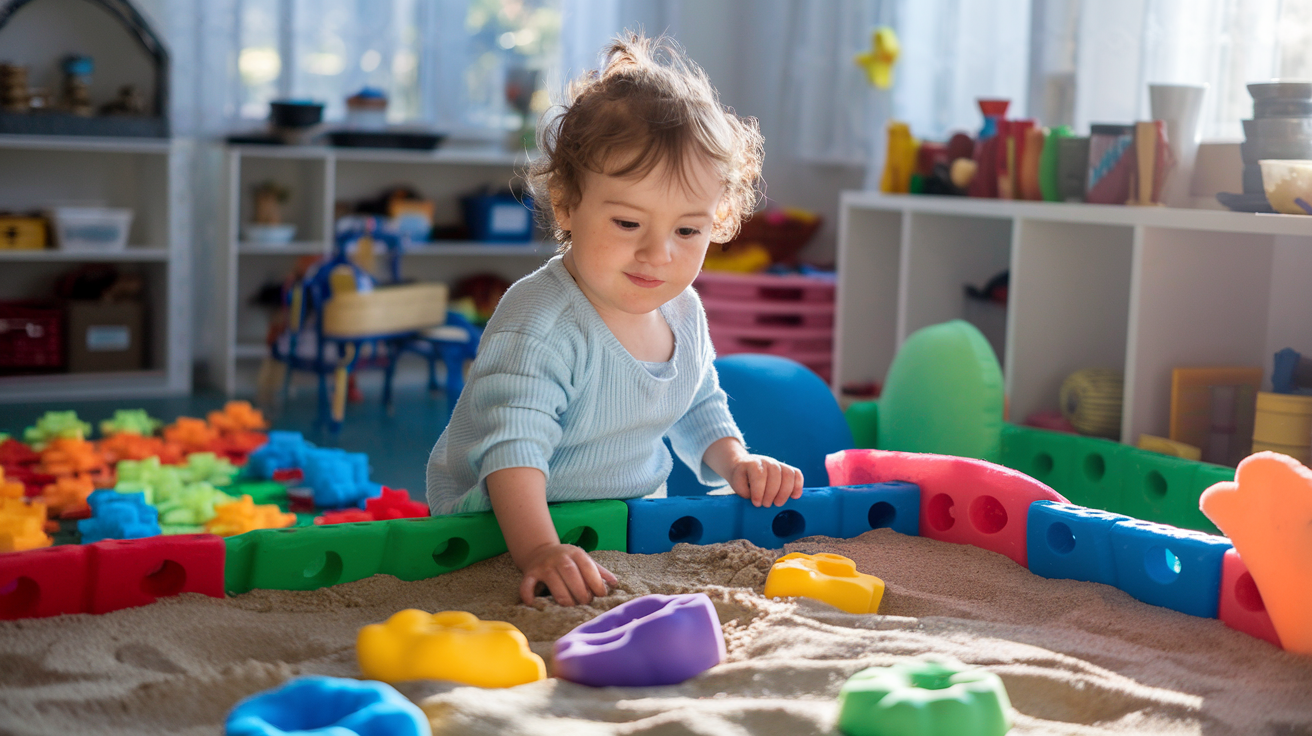Autism Spectrum Disorder (ASD) is a developmental difference that affects how a person interacts with the world around them. Children on the autism spectrum often experience challenges with social communication, understanding social cues, and building relationships. These skills are crucial for navigating friendships, school environments, and everyday life. But there’s a powerful tool that can help: play!

Play provides a natural, engaging environment for autistic children to develop their social skills in a way that’s fun and stress-free. It sets the stage for them to practice communication, empathy, cooperation, and build the foundations of lasting connections with others.
In this blog post, we’ll dive deep into the ways play transforms the lives of autistic children. We’ll discuss:
- Why play is essential for children with autism
- The best types of play for fostering social skills
- Strategies for parents and educators to promote play
- Resources for getting started with play-based support
Let’s unlock the power of play!
Why Is Play Essential for Children with Autism?
Play may seem like a simple childhood activity, but for autistic children, it holds immense potential for growth and development. Here’s why play is such a powerful tool:
- Natural learning environment: Unlike formal therapy sessions, play provides a relaxed and enjoyable space to practice social skills. Children feel less pressure and are more likely to engage spontaneously.
- Reduces stress and anxiety: Many autistic children experience sensory sensitivities and can become overwhelmed. Play, especially sensory-rich activities, can be incredibly calming and provide a positive outlet for self-regulation.
- Increases motivation and engagement: When play is centered around a child’s interests, they are naturally more inclined to participate and interact. This enthusiasm provides a perfect setting for practicing social skills in a way that feels organic and fulfilling.
- Builds foundational social skills: The act of play involves many actions that directly translate to social success: taking turns, sharing ideas, negotiating rules, problem-solving, reading facial expressions, and expressing needs and emotions.
Play isn’t just about having fun (although that’s important too!). It’s a pathway for autistic children to learn, grow, and connect with the world around them. Think of it as a child’s superpower for building the skills they need to thrive.
The Best Types of Play for Autistic Children to Build Social Skills
There isn’t a one-size-fits-all approach to play for children with autism. Here’s a look at different types with a focus on building social connections:
Structured Play: These games have clear rules, set expectations, and often involve turn-taking. Examples include board games, card games, simple sports (kicking a ball back and forth), and building projects. Structured play encourages cooperation, understanding of social norms, and adaptability when unexpected things happen.
Sensory Play: Sensory play engages a child’s senses of touch, sight, sound, smell, taste, and movement. Popular activities include playing with sand, water, finger painting, playing with textured materials, listening to calming music, or swinging. Sensory play can reduce anxiety and create a sense of calm, opening opportunities for interacting with others.
Imaginative Play: This includes role-playing, pretend play, storytelling, or dress-up. Imaginative play allows children to step into different roles, practice different perspectives, and explore social scenarios in a safe and engaging way. It promotes communication, empathy, and creative expression.
Construction Play: Building with blocks, creating with Legos, solving puzzles, drawing, or even crafts all fall into this category. Construction play encourages problem-solving, spatial reasoning, and a sense of accomplishment. It can be done independently, offering self-soothing moments, or collaboratively by working on a project together.
Technology-Based Play: This is a more modern play category, including computer games or apps tailored toward social skill development. Look for options that encourage cooperative play or virtual interaction. These activities can be helpful for practicing skills in a controlled, structured environment.
Important Note: The most impactful play activities are those that align with your child’s current interests and strengths. As a parent, teacher, or therapist, your best role is to observe your child and build on what they find naturally engaging.
Tips for Parents: How to Encourage Play and Social Development at Home
Parents play a crucial role in creating a playful home environment that fosters their autistic child’s social development. Here are some simple yet effective strategies:
- Observe your child: What sparks their curiosity? What activities seem to bring them joy? Tailoring play around their interests is key to creating a positive and engaging experience.
- Set up a play space: Designate an area in your home with a selection of toys and materials that encourage different types of play. This could be a simple play corner with a rug or a table for activities. Keep it organized and inviting.
- Start small and gradually increase: Begin with short play sessions of 5-10 minutes several times a day. As your child shows interest and engagement, gradually increase the duration. The focus should be on creating positive associations with play.
- Narrate and participate: Verbalize your actions and your child’s during play. (“You’re putting the red block on top!” “Look, the car is going down the ramp!”). This models language and social interaction. Join in the fun and let your child take the lead while you enthusiastically participate.
- Focus on fun: Prioritize enjoyment over strictly focusing on specific skills. When play is joyful, children are naturally motivated to participate and learn. Let your child’s playfulness guide the way!
Remember: Play is a process, not a rigid lesson plan. Be patient, flexible, and let the joy of play lead the way! If you find yourself needing inspiration, books on play for autistic children can be a fantastic resource, like the gentle and supportive ideas you’ll find in “Ausome Parenting: The Guide to Endless Love, Emotional Support and Acceptance for Your Autistic Child” (https://ausomeparentingbooks.com/autism-books/).
How Educators Can Use Play for Autism Inclusion in the Classroom
Play-based strategies are incredibly powerful for educators working towards creating a more inclusive environment for autistic children. Here are a few ways teachers can incorporate play into the classroom setting:
Peer-mediated play: This involves training typically developing children to initiate interactions with autistic classmates with guidance from the teacher. This can be done through structured activities focused on sharing, taking turns, or collaboration.
Structured play groups: Educators can organize small group activities with clear goals and an intentional focus on social skills practice. These groups may rotate through different play stations or be structured around a specific theme.
Classroom play centers: Designate areas in the classroom for different types of play. A building corner with blocks, a sensory table, a dress-up area for imaginative play, and a quiet reading corner give children choice and facilitate interaction between peers with varying interests.
Incorporate interests: Build on popular characters, themes, or specific topics that children enjoy. This increases engagement and opens natural opportunities for practicing social skills. Imagine a dinosaur-themed construction center or a superhero imaginative play corner!
Collaboration is Key: Educators can team up with occupational therapists or speech-language pathologists specializing in autism to develop targeted play-based interventions. These professionals can offer tailored strategies and activities to support individual students and promote classroom-wide inclusion.

Where to Find Resources for Play-Based ASD Support
Parents, educators, and therapists have a wealth of resources available to deepen their understanding of play-based support for autistic children. Here are a few starting points:
Occupational Therapists (OTs) and Speech-Language Pathologists (SLPs): These healthcare professionals have special expertise in autism and child development. OTs focus on sensory integration and motor skills while SLPs specialize in communication. They can offer personalized assessments, strategies, and even direct play therapy sessions.
Play Therapy Resources: There are numerous books, websites, and online communities dedicated to the power of play therapy. Search for play therapy resources specifically geared toward autism to find relevant information and support.
Support Groups for Parents: Connecting with other parents raising autistic children is invaluable. Support groups offer a space to share experiences, learn from one another, and gather recommendations for local resources and play-based programs.
Here are some additional helpful websites:
- The PLAY Project: https://playproject.org/
- Autism Speaks: https://www.autismspeaks.org/
- Early Autism Services: https://www.earlyautismservices.in/
Measuring Progress: Is Play Helping Your Child Develop Social Skills?
Observing your child and tracking their unique journey is essential for understanding whether play-based strategies are yielding positive results. Here’s how to measure progress:
Observation: Take the time to observe your child during play. Note their engagement level – how long do they play, and do they show enthusiasm? Watch for instances of spontaneous social interaction, like initiating play with others or responding to peers. Notice the development of new skills, whether it’s making eye contact, using new words, or problem-solving.
Collaboration with Therapists: If your child works with an OT or SLP, discuss your observations with them. They can provide a professional perspective on the progress they see during therapy and suggest ways to track milestones objectively.
Progress may look different for every child:
- Increase in spontaneous play initiation
- More positive interaction with peers or family members
- Increased eye contact and nonverbal communication
- Development of new skills in areas tied to social play, like turn-taking, sharing, or role-playing
- Enhanced creativity in imaginative play
Important note: Don’t become discouraged if progress isn’t immediate. Focus on celebrating small victories, observing patterns over time, and enjoying the journey with your child.
Conclusion
Play is truly transformative for children with autism. It’s more than just having fun – it’s about unlocking potential. By understanding how play benefits autistic children and providing environments rich with opportunities for exploration, parents and educators can foster the development of crucial social skills.
Remember, finding the right types of play for your child is a personalized journey. Start with their interests, create a playful atmosphere, and always keep it fun! Embrace the power of a multi-faceted support system, including therapists, resources, and your own unwavering love and support.
Let’s continue to empower autistic children through play, paving the way for a future filled with social connections, joy, and fulfilling experiences.


